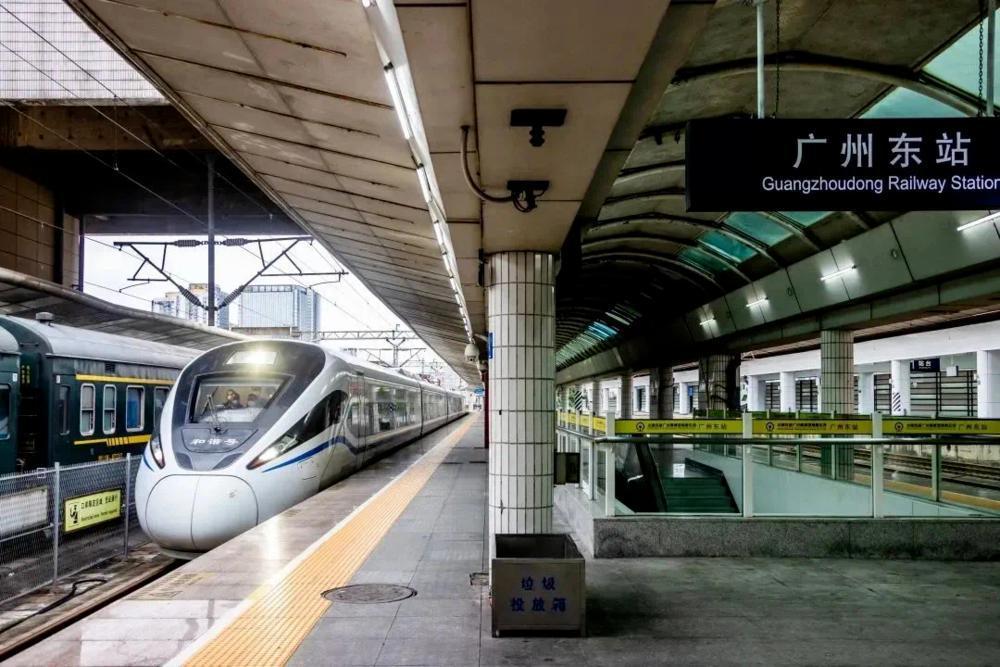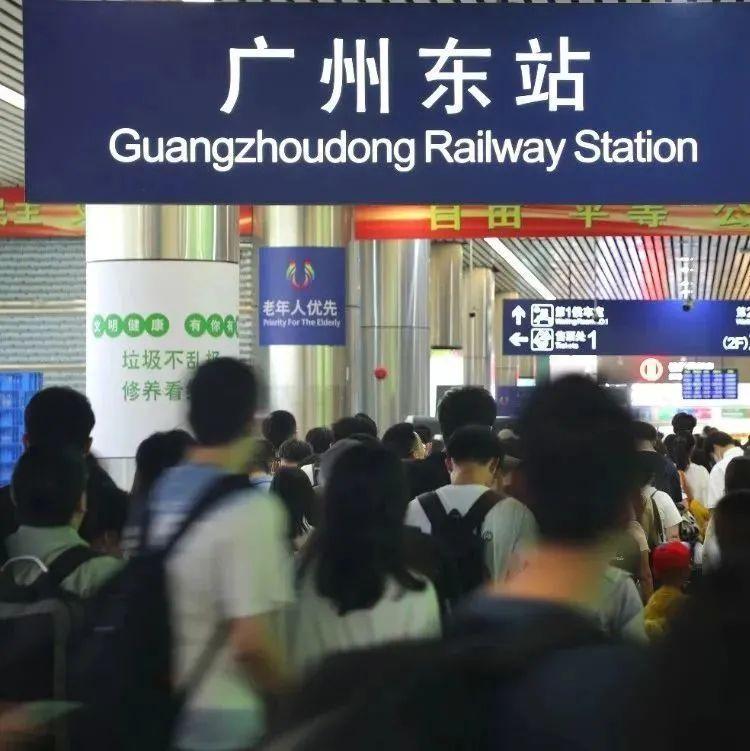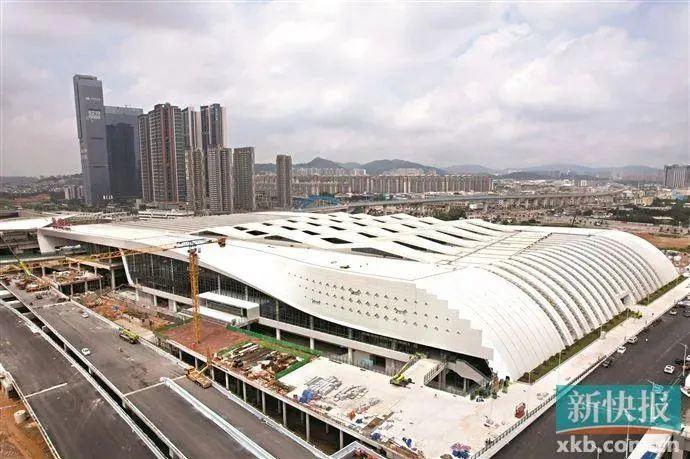
Recently, the renovation plan for Guangzhou's railway hub has been unveiled. In addition to the construction of the new Guangzhou East to Xintang rail lines, it includes the much-anticipated upgrade of the Guangzhou East Railway Station into a high-speed rail hub.

Guangzhou East Railway Station will be transformed into a high-speed rail station using a double-deck layout of "ground-level and underground connected rail yard". After the renovation, the station will expand its capacity, going from the current 7 platforms to a total of 14 platforms. This expansion will consist of 8 ground-level platforms with 14 tracks and 6 underground platforms with 10 tracks. The station will be revamped with a double-deck design, featuring north and south-side station buildings and an elevated waiting area.

The Guangzhou East to Xintang rail project runs through the Tianhe, Huangpu, and Zengcheng districts within Guangzhou. It stretches from Guangzhou East Railway Station in the west to Xintang Station in the east, running parallel to the existing Guangzhou-Shenzhen railway line.
The rail line starts from Guangzhou East Railway Station and follows the original track, passing beneath the Wushan Road Bridge. It then proceeds to the north side of Hanjing Road, entering a tunnel. Continuing southward alongside the Guangzhou-Shenzhen railway, it emerges on the surface after reaching Fenglebei Road. The line then moves eastward, passing underneath Zhendong Road while crossing over Wuchong, Wenchong. Afterwards, the line continues towards the east, descending into a tunnel under the China Petrochemical coal transportation channel and the Guangdong-Macao Expressway. It then merges onto the northbound track of the Guangzhou-Shenzhen railway, passing beneath multiple highways, municipal roads, and the Guangzhou-Dongguan-Shenzhen intercity railway, finally connecting to the Guangzhou-Shantou high-speed rail line at the designated location in Xintang Station.

The entire rail line includes two railway stations, Guangzhou East and Xintang. Guangzhou East Railway Station is an existing station being renovated, while Xintang Railway Station is an existing station along the Guangzhou-Shantou railway. Additionally, the project also reserves space for a future Huangpu Railway Station. This rail project is classified as a high-speed rail line and will be powered by electricity. It is designed for a maximum operating speed of 200 kilometers per hour.
The project includes two main tunnels for the Guangzhou East to Xintang rail line, Guangxin Tunnel 1 at 11.268 kilometers in length and Guangxin Tunnel 2 at 13.801 kilometers, with a combined length of 25.069 kilometers and a tunnel ratio of 83.5%. Most trains on this rail segment will run underground, earning it the nickname "underground high-speed rail." This is similar to the Guangzhou-Guangzhou South Station connecting line which went into construction on September 27th and is designed for speeds of 200 kilometers per hour. With the completion of these two rail lines, the "high-speed rail into the city" network in Guangzhou will become even more comprehensive.
This project is designed to accommodate the introduction of eastbound high-speed rail into the hub, expand the hub's connectivity to eastbound routes, accelerate the integration of infrastructure within the Greater Bay Area, and support the national development strategy for the Greater Bay Area.
广州东站将升级成高铁站!站台规模增加一倍
近日,广州铁路枢纽的改造方案出炉,整套工程除了新建的广州东至新塘五六线外,还包括备受关注的广州东站升级改造成为高铁站。
广州东站将按照“地面+地下贯通车场”双层车场方案改建车站。改造后广州东站升级为高铁站,车场总规模有14个站台,比目前7个站台的规模增加一倍。其中地面场8台14线、地下场6台10线,站房结合站场双层布局改建后设南北侧式站房、高架候车室。
广州东站至新塘站五六线工程位于广州市天河区、黄埔区、增城区境内,西起广州东站,东至新塘站,与既有广深铁路并行。
线路自广州东站引出,利用原动走线路径路基下穿五山路桥梁后,于翰景路北侧向下进入隧道,沿广深铁路南侧行进至丰乐北路后露出地面,依次下穿镇东路上跨乌涌、文涌后线路继续向东,隧道下穿中石化运煤通道、广澳高速后折至广深铁路北侧行进,下穿多条高速、市政道路及穗莞深城际后,接上广汕高铁于新塘站预留线位。
全线设广州东、新塘两座车站,其中广州东站为既有站改建,新塘站为广汕铁路既有车站,线路中还预留一个黄埔站。该工程铁路等级为高速铁路,采用电力牵引,设计速度200公里/小时。
据介绍,广州东至新塘五六线新建正线隧道2座,广新1号隧道长11.268公里,广新2号隧道长 13.801公里,共长25.069公里,隧线比为83.5%。该段铁路上的列车大部分在地下行驶,堪称“地下高铁”。这点与今年9月27日开工、设计时速同为200公里的广州站至广州南站联络线相似,两条线路建成后,广州“高铁进城”的格局将更加完善。
本项目建设是适应枢纽增加引入东向高铁、扩大枢纽衔接东向通道能力、加快粤港澳大湾区基础设施互联互通、落实大湾区发展国家战略的需要。
翻译 | 刘佳慧
-
Video | "Belt and Road" traders converge on Canton Fair
2023-10-16 23:11:00 -
Photos | Rural revitalization in golden Populus Euphratica forest | Guangdong assisting Xinjiang
2023-10-16 23:11:39 -
Xinjiang-supporting textile project brings locals a better life | Guangdong assisting Xinjiang
2023-10-16 23:11:57 -
Shanhai Salon made its debut in Yuexiu District to discuss the intercultural communication of Guangdong films
2023-10-16 18:00:34






